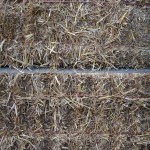To meet UK building regulations use the written Standard below to ensure the bales are good enough for construction. Building Inspectors should use this standard when visiting site, and should read the book (Building with Straw Bales by Barbara Jones) on good installation details in order to make sure that the straw is being installed correctly.
Bale sizes vary in the UK but the most common are 18” x 14” and the optimum length is 41” (460 x 355 x 1040mm) design should be based on sizes after compression, dressing and trimming which is 450 x 345 x 1000mm. If bales are less dense, the compressed height will be less than 345mm.
How to choose good building bales – brief summary
Bales should be dry, well compacted with tight strings, be of a uniform size and shape, and contain virtually no seed heads. Straws should be quite long, at least 150mm (6”). They must not be damp, and must be protected from moisture during the building process. There should be no signs of vermin having nested during storage.
Bale standard
- Bales must be dry, with a moisture content below 20%.
- Bales should be dense and compact. The baling machine should be set to maximum compression; in general this means bales contain about one third more straw than usual. For two-string bales, mass should be between 16kg and 25kg.
- Density should be at least 80 kg/m³. Greater density is recommended for loadbearing. Compression will increase this by 3 – 6%, the equivalent of 1 – 2cm/bale settlement.
- Bales should be regular and uniform in shape. They should not have missing corners, nor be curved, nor be of different heights and widths.
- Bales should be more than twice as long as they are wide for loadbearing but can be shorter for infill. They are usually measured in imperial units rather than metric: about 41″ (1.04m) long on average is good that reduces to 1m after dressing.
- Strings must be ‘very tight’ – as a practical guide the strings should be tight enough so that it is difficult to get fingers underneath. They should be about 100mm (4″) in from the edges of the bale and not sliding off the corners.
- Variety of straw can be wheat, barley, rye, oats, rice etc. Rye would be a good choice as it contains a natural fungicide so is very resistant to rot, but currently (2021) is difficult to source. Winter wheat is a good choice as it is more durable than spring wheat, having had to survive harsh weather conditions.
- Straws should be long, preferably at least 150mm (6″). Use bales from a straw walker type of harvesting machine for longer straws. Avoid bales of straw chopped by the harvester.
- There should be no signs that vermin have set up home in the bales during storage.
- Stored bales should be raised off the ground on pallets or similar – by at least 150mm if outside – and weatherproofed but allowing for good ventilation especially at the top of the stack.
- String will most likely be polypropylene but could be sisal or hemp baling twine for a low environmental impact.
Do not confuse straw with hay or grasses. Straw is the baled-up dead plant stems of a grain crop. It has had virtually all its seed heads removed, and contains no leaves or flowers. It is a fairly inert material, with a similar chemical make-up to wood. It does not decompose easily, usually requiring the addition of nitrates to do so. Hay, on the other hand, is grass baled up green, with lots of feedstuff (leaves, flowers, etc.) deliberately left in because it is fed to animals. It readily decomposes, unlike the dead plant stalks of straw.
The age of the straw does not matter as long as the above conditions are fulfilled, and it has been stored correctly. All the above conditions apply equally to all bales, whether they are being used for load-bearing or infill.
Bale size and length
It is important to know the length of bales you will be using before finalising the dimensions of foundations, wall plate, roof plate, etc. Bales can vary in length, from supplier to supplier and within each load, since whether or not the straw is picked up uniformly as it is baled depends on the skill of the tractor driver and the evenness of the field.
In practice, relying on the farmer to tell you the length of bales is not a good option, as you are unlikely to get an accurate picture. Besides which, you will need to satisfy yourself that the straw is baled dry, and kept dry while in transit and storage. It is far better to look at the bales once they’re harvested and determine the average length of bale at the same time. The best way of doing this is to pick 10 bales at random and lay them tightly end to end. Measure the whole and divide by ten to find the average. Now you have to bear in mind that when you use these for building, you will dress them first and this will normally reduce the average length by 30-40mm. So a bale that measures on average 1.1m (43”) is likely to end up as only 1.06m (41”)
It is almost impossible to measure the length of one bale accurately; give 3 of your friends a tape measure and ask them to do it – you’ll find they all come up with different answers – and they’re all correct, in a way! However, if you find that your delivered bales are not the same length as you expected, this is not an insurmountable problem. It may mean a little more work in shaping the bales to fit, but this is straightforward and not too time-consuming. To accurately measure the width and height of the bale, lay one on a flat surface, place a spirit level on the top, make it level and measure down to the ground. You should only need to do this for a couple of bales as they should be identical, having come out of the same machine. This gives you the height of the bale when laid flat. Turn the bale by 90 degrees onto its side and repeat the process to find the width of the bale.
As straw bale building becomes more widespread, good-quality construction bales are becoming more readily available, and the wholesalers who can supply them can be found listed under Agricultural Merchants or Straw Merchants in directories. It is possible to harvest and store straw in bales of uniform length and moisture content, ready for the building market each season, and wholesalers are starting to do this. As long as they are kept dry and well ventilated, they can be stored for a long time before using. As demand increases, so will the reliability and availability of supply.
In terms of design, measure the bales as above and use an average length as your standard block – usually 1m. The width and height should be identical for all. If it isn’t – go to another supplier! When designing, you will need to make a good estimate of how much the bale will compress under load – for the very best bales this is only 10mm (3/8”) per bale – and make your finished design based on these, and your construction drawings should mention both values, compressed and uncompressed.
Construction-grade bales
As more and more buildings are being constructed out of straw, this has given us the opportunity to really find out which are the best bales for building. It is possible to order ‘construction grade’ bales from particular wholesalers who are familiar with the above requirements. These bales are often made using a modern baling machine which creates very dense, uniform bales that are delivered to site in packaged bundles with 21 on a pallet. Their dimensions may be 1,050mm x 355mm x 460mm (42″ x 14″ x 18″). Knowing what your bale dimensions and properties are makes a big difference when you are designing and building.
If using pre-compression methods, these bales are so dense that they will each compress by no more than 10mm (3/8″) per bale, so you can also predict with greater accuracy what the settlement of the walls will be and factor that in to the building process. Although it is still possible to use other types of bales, you must remember that there may be greater settlement on the walls, and allow for 25mm (1″) or more per bale if using pre-compression methods or a reasonably heavy roof with unknown bales.


